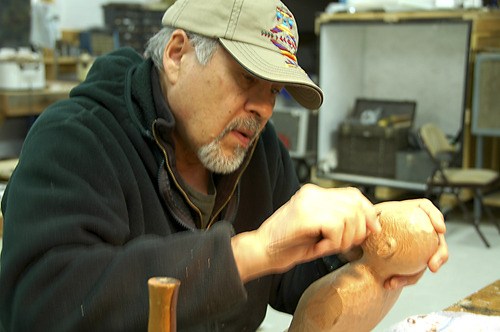Feeling the effects of winter’s dark days? Be glad you’re not Inupiaq. In Barrow, Alaska, the sun sets around Nov. 18 and doesn’t return until Jan. 23. As the world’s most northern aboriginal people, the Inupiaq sustained themselves for centuries through the dark, frozen winters by gathering to celebrate the dawn, the return of the light, with a Messenger Feast.
During the celebration, or “Kivgiq” in Inupiaq, the people would dance, feast, tell stories, assess the year’s hunt and fend off isolation. The tradition was integral to village life until it was banned in the early 20th century.
“Traditional religion has been lost,” said Inupiaq carver Lawrence Ahvakana, who lived in Barrow, Alaska, as a young boy.
The Feast was revived in 1988 as a means of cultural revitalization, a dawn after a dark time.
“They brought back the dances that were considered taboo or demonic,” Ahvakana said. “They weren’t. They were celebrations.”
Ahvakana, who works with a variety of materials including wood, stone, glass, and bronze, will show two dozen pieces inspired by his Inupiaq roots at Bainbridge Arts and Crafts this month. The work includes the 16-foot-wide “Qaluquq,” comprised of three wooden panels made from reclaimed old-growth red cedar. The central panel is for a box drum, which represents the heartbeat of the sacred Mother Eagle from whom the seasonal ceremony was said to have originated. The side panels contain fused glass moon shapes depicting seasonal movement, Ahvakana said. Along the bottom are flukes.
“It is a tally, telling how many whales were caught that year,” he explained.
“I felt a need to give people an idea and background of the visual parts of our people, the activities of our people,” said Ahvakana, who studied and taught at the Institute of American Indian Art in Santa Fe, N.M.
Ahvakana, who also has a BFA from the Rhode Island School of Design, shows work at Stonington Gallery in Seattle, in Cannon Beach, Ore., New York, Maine, Anchorage and Portland.
He is currently working on a commission for the library in Barrow. The piece is 28-feet long, 3-feet-high, comprised of 14 backlit glass panels for a long hallway.
By CONNIE MEARS, Staff Writer



